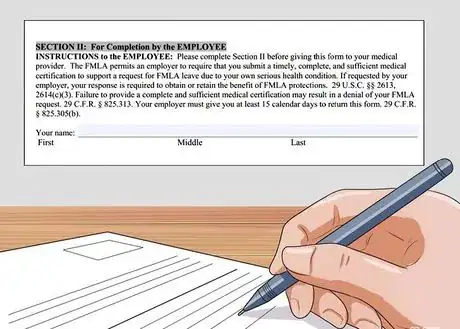This article was co-authored by Jeffrey Fermin. Jeffrey Fermin is a Performance Marketing Manager based in Miami, Florida, who currently works for AllVoices. He’s also the Founder of a full-service marketing company called New Theory. With over 10 years of experience, he specializes in digital marketing and content creation. He earned a Bachelor’s Degree in Psychology and a Bachelor of Education from Florida International University. Jeffrey has won a Microsoft Octas Innovation Award and is a TechCrunch Disrupt Runner-Up.
There are 10 references cited in this article, which can be found at the bottom of the page.
This article has been viewed 149,345 times.
While it is important that employees are able to take time away from work to deal with life events and problems, it is also important that it does not become a regular occurrence that results in lost productivity and problems for other employees. Additionally, chronic absenteeism can be an indication that the employee is unhappy in his work.[1] In the case that an employee is missing work frequently and regularly, it becomes important to take steps to manage the issue.
Steps
Understanding the Law
-
1Be aware that there are several laws in place to protect employees from being disciplined or terminated wrongfully. Before you begin the process of addressing employee absence, make sure that you are adhering to the law.
-
2Understand the Family and Medical Leave Act (FMLA). The purpose of FMLA is to protect employees from disciplinary action when major life events occur. Be aware that while these employees are protected under this act, the employee must provide notice that he will be absent from work for one of the reasons protected under FMLA, and documentation must also be provided (e.g. doctor's note, evidence of adoption, etc.).[2]
- This includes the birth of a child, caring for a newborn child up to the ago of one year.
- Adopting a child and caring for a newly adopted child during the first year.
- Caring for a parent, spouse or child with a serious health condition
- Being unable to perform job duties as a result of a serious health condition.
- Emergencies arising from the child, spouse, or parent of an employee as a result of being involved in the military.[3]
Advertisement -
3Be aware of the Americans with Disabilities Act (ADA). If you have an employee with a disability, as an employer, you must provide accommodations so that he can perform his job without undue hardship. [4] If this applies to your employee, he may be missing work because he cannot perform his job properly, and may need assistance. Make sure that this is not the case before taking any disciplinary action.
- Undue hardship is defined as, "action requiring significant difficulty or expense" when considered in light of a number of factors, including how much the accommodation will cost and its nature in relation to the size, available resources, nature of the work, and structure of the company.[5]
-
4Learn about Title VII of the Civil Rights Act. This act protects people from being discriminated against on the basis of gender, race, color, national origin, or religion.[6] Like with the ADA, you should ensure that your employee is not absent from work because, for example, of a religious ceremony he must attend, before taking disciplinary action.
-
5Understand the Uniformed Services Employment and Reemployment Rights Act (USERRA). This act protects service members rights to employment and reemployment upon returning from a period of service.[7] If your employee has recently returned from a tour of service in the military, including the reserves and National Guard, he may be dealing with emotional issues, administrative issues, etc. that are preventing him from working.
-
6Make sure you are very familiar with your company's attendance policy. You are likely already familiar with what the company policy on attendance is; however, it doesn't hurt to refresh your memory, especially if you have to confront an employee about his attendance.
Assessing the Problem
-
1Determine whether or not an employee has a pattern of absenteeism. This may be clearly outlined in your company policy, or you may have to determine it based on comparisons of other employees in similar working positions.[8]
- Keep in mind that if your employee is covered by one of the laws discussed in Part 1, you may have to adjust accordingly.
-
2Find out whether the absences were legitimate. If the absent employee has demonstrated that he missed work because of a recurrent health problem, a disability, a death in the family, or jury duty, and particularly, and if he has provided documentation, such as a doctor's note or note from the court, then the employee has a legitimate reason.
- In this case, it is unlikely that you will need to take any disciplinary action. However, you can ask the employer to provide notice of when and how often s/he will need to take off work if, for example, the absences are related to a health problem. While it is not appropriate to ask for information or details about any diagnosis, it is fair to ask for documentation from the doctor so that you can plan around the needs of the employee.[9]
- Be aware that what constitutes a legitimate excuse may be different in different situations. Take each reason on a case-by-case basis. If your employee has an explanation that you believe, and evidence to back it up, then give them the benefit of the doubt. You don't want your employee to feel as though he is distrusted and constantly needs to defend himself, as this can result in stress and dissatisfaction for the employee.
- If your employee does not have good explanations or evidence for his absence, continue with steps to address the issue.
-
3Review past attendance records. Take some time to review the employee's performance and attendance history. If the employee has been with the company for several years and has been a stellar employee in terms of performance and attendance, then a new pattern of absence likely has a legitimate reason, or could indicate that the employee is no longer happy in his job.
Communicating the Problem
-
1Ask your employee for a meeting. Try to do this discreetly, via email if possible. You don't want to embarrass the employee, particularly if they have good reasons for their absence.[10]
-
2Explain the problem to them. Calmly explain your concerns about their absenteeism to them. Simply state that you have seen a pattern in their absenteeism, and that you want to determine if these absences are legitimate, or if you need to work together to improve the issue. Avoid stating any suspicions you have about their absences, as this may cause the employee to become defensive.
-
3Determine the Cause of Absence. Give the employee a chance to explain his absences. Be aware that he may have to share very personal information with you about a family crisis or health issue, so do your best to be compassionate and patient.
- Also be aware that he may not have a good excuse for his absence. In this case, you should still remain calm and concerned. It will not be helpful to scold the employee or make them feel even more embarrassed, particularly if you are interested in keeping them as an employee.
-
4Avoid taking responsibility for the employee's absence. Remember that it is not yours or the company's job to fix your employee's non-work related problems. Instead, your job is to provide them with the resources they need to do their job well.[11]
-
5Explain why absenteeism is a problem. Explain that while absence is sometimes unavoidable, chronic absenteeism hurts the company and creates extra work for others. When your business is doing its peak volume, it's especially important for him to be there as scheduled. It can also create interpersonal conflict within the work team if people are picking up the slack for someone who does not adhere to the attendance policy.
-
6Provide a verbal warning. If you have determined that the employee's chronic absence is not related to legitimate issues, warn the employee that he needs to improve or face disciplinary action.[12]
- Document the meeting and make it clear that a verbal warning was given. It is important to have evidence that you discussed the matter with the employee, and that it is clear what went on in the meeting. This could help avoid future disagreements about what went on and what didn't.
Creating a Plan of Action
-
1Set clear standards.[13] If your company already has specific guidelines about attendance, lay them out for your employee. Otherwise, give him concrete guidelines about how his attendance will be monitored (e.g.he is not allowed to miss work for the next 6 months, or he will be disciplined). Be clear about which situations constitute legitimate reasons, and which do not.
- Provide a company of the employee handbook, if applicable. Mark the page that contains the information about attendance, and the consequences of missing work.
- Make sure the employee understands your policies on paid and unpaid leave. If he is entitled to sick time, vacation time or unpaid days off, explain that you need notice so you can adjust the schedule. He must call in sick at opening time to use a sick day, and provide a doctor's note, if your policy calls for this. Also explain who must approve any leave time; this could be you, or another supervisor, but be clear.
-
2Warn your employee about the consequences of failing to improve his attendance. Make sure your employee understands that he must work to improve his absenteeism, and that if he is unable to do so there will likely be consequences including possible termination from the job.[14]
-
3Ask your employee if there is anything you can do to help him improve. Sometimes, absence can be a result of not wanting to deal with situations at work. Your employee may be being harassed by another employee, he may feel suffering from burnout, or he may feel dissatisfied with a particular aspect of his job.[15] You may be able to help him deal with certain work-related issues, so take the time to see if you can do anything to improve the situation.
-
4Confirm the plan in writing. Once you and the employee have discussed the problem, it's causes, and how the both of you will work together to improve the problem, create a document that conveys this information. Include a statement explaining that the employee has understood the possible consequences if he does not improve as well as a place for signatures from you and the employee.
- Ask your employee to read through the action plan and sign it. Explain to him that by signing the document, he is indicating that he understands the information contained in the document.
- Make a copy of the document for the employee to keep, and place the original in the employee's file.
Monitoring the Employee
-
1Enforce attendance rules. Remind all employees of the rules and enforce whatever your policy dictates for disciplinary action. As a rule of thumb, give one or two reminders before writing him up.
- Be consistent in your enforcement. If you look the other way sometimes but not others, or show favoritism toward some employees, you will create a chaotic environment where employees feel resentful and take advantage of your inconsistency.
-
2Keep an eye on attendance. With a plan of action for improving the employee's attendance, you will need to make sure he is following through. Regularly check the employee's attendance records each month. While the employee may adjust his behaviour initially, he may fall back into old habits if he feels he can get away with it.[16]
-
3Praise your employee. If the employee is able to improve his performance, be sure to take time to give him praise. This way, he knows that you are paying attention, and that you haven't failed to notice his efforts.
-
4Consider disciplinary action. On the other hand, if your employee fails to improve his attendance, consider taking disciplinary action. This might mean providing a written warning, it may mean suspending the employee without pay for a period of time, or it may mean termination of the employee.
- Deciding on the right kind of disciplinary action should be done by considering the history of the employee, the reasons for his absence, as well as your company's policy.
Community Q&A
-
QuestionMy employee lives with her brother who is very sick. She has called out 9 times in the last 3 months. Is this something I can address?If there isn't some type of health insurance coverage for services like a hospital, nursing facility or good home care that can come in to look after your employee's brother while she works, there's not much she can do about the situation. It's not really an answer to your employee's problem, but this is where calling in a qualified temp could help you fill in the gap in the meantime.
References
- ↑ http://www.forbes.com/sites/investopedia/2013/07/10/the-causes-and-costs-of-absenteeism-in-the-workplace/
- ↑ http://www.dol.gov/whd/fmla/employeeguide.pdf
- ↑ http://www.dol.gov/whd/fmla/
- ↑ http://www.dol.gov/dol/topic/disability/ada.htm
- ↑ https://adata.org/faq/what-considered-undue-hardship-reasonable-accommodation
- ↑ http://www.aauw.org/what-we-do/legal-resources/know-your-rights-at-work/title-vii/
- ↑ https://www.dol.gov/vets/programs/userra/compliance.htm
- ↑ http://www.hrvoice.org/keeping-workers-at-work-managing-absenteeism-in-the-workplace/
- ↑ http://www.hrvoice.org/keeping-workers-at-work-managing-absenteeism-in-the-workplace/
- ↑ http://www.masterclassmanagement.com/ManagementCourse-DealingWithAttendance.html
- ↑ http://www.hr.wa.gov/WorkforceDataAndPlanning/ResearchAndResources/HRManagementIdeaBank/Pages/ManagingAttendanceIssues.aspx
- ↑ http://www.masterclassmanagement.com/ManagementCourse-DealingWithAttendance.html
- ↑ http://www.hr.wa.gov/WorkforceDataAndPlanning/ResearchAndResources/HRManagementIdeaBank/Pages/ManagingAttendanceIssues.aspx
- ↑ http://www.hrvoice.org/keeping-workers-at-work-managing-absenteeism-in-the-workplace/
- ↑ http://www.forbes.com/sites/investopedia/2013/07/10/the-causes-and-costs-of-absenteeism-in-the-workplace/
- ↑ http://www.hr.wa.gov/WorkforceDataAndPlanning/ResearchAndResources/HRManagementIdeaBank/Pages/ManagingAttendanceIssues.aspx




















































































